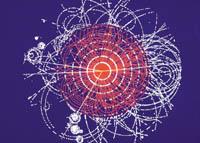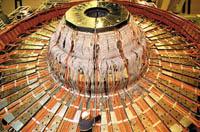CERN: Study of particle physics in Europe

The European Nuclear Research Organization (CERN) has decided to close the LEP particle accelerator (Large Electron-Positron collider) between France and Switzerland. Initially they had to be closed in September 2000, but in the hope of finding the mysterious particles of Higgs, they decided to postpone the closure to November 2. The detection of Higgs particles would be a great step towards understanding the origin of the particle mass. In spite of the rather encouraging conclusions, it has been preferred not to prolong the activity of the ERVs until 2001, since it would have great influence on the construction of the LHC accelerator and the rest of the CERN projects.

The director of CERN, Luciano Maiani, has stated that it has not been an easy decision, since the OPE had a capital importance in European scientific research and the total recognition of people working in particle physics. In fact, OPE was the first much more advanced European accelerator than in the United States. However, they point out that this difficult decision was necessary, despite the numerous results obtained in the continued activity of eleven years, since the OPC did not guarantee sufficient precision. For example, to know the energy contained in the particles, it is necessary to know precisely their trajectory. The problem is that due to the action of the moon and the sun, the soil is slowly deformed, so despite generating a deformation of one millimeter in a length of 27 kilometers, it is an effect to consider in the studies of the CERN. However, Europeans who work in particle physics have no reason to worry, since in the same place the LHC accelerator will fill the gap left by the LEP. The LHC accelerator will allow to work on high energy of a teraelectronvolt.
What is a particle accelerator?
Accelerators are used for the investigation of the elementary particles that form the matter and, according to experts, are the main and most accurate scientific instruments elaborated by man. There are two types of accelerators: linear (called linac) and circular (cyclotron), but both are necessary for the electric field and magnetic field. The electric field provides energy to the particles, accelerating them, while the magnetic field maintains the exact focus of the particle beam. In the linacs, the particles filter continuous electric fields that increase their energy, while in the cyclotrons, turning and passing through the same electric field, they manage to store energy. As the velocity of the particles accelerates, the tendency to deviation also increases and, at this level, the main advantage of the OPE was: Thanks to a circumference of 27 kilometers, the smallest curve could be affected.

The last key parts of the accelerators are detectors to observe the particles and their shocks. When the particles reach a relatively high speed, they break against the fine ones or by shock. The detectors allow to identify the particles and determine their trajectory. The OPE had four detectors: Aleph, L-3, Delphi and Opal.
Discoveries of the LEP accelerator
Undoubtedly, the LEP particle accelerator is one of the most important symbols of European scientific research. Since its launch eleven years ago until the last month, it has witnessed continuous discoveries. Experts in particle physics have performed only praises, year after year, in an accelerator in which more and more precision measures have been made.
As a result of these measures, physicists are working on the union of four interactions, electric, magnetic and nuclear violent and weak. Already in the theory called the standard model in particle physics, weak electromagnetic and nuclear interactions have been joined, and there is now a need to add strong nuclear interactions (subnuclear). However, thanks to measures of great precision, this last theory and the standard model, in the history of physics, has become the most complete and developed conceptual framework.
Concrete measures include the intensity of violent interactions, mass, and the most accurate properties of Z and W particles. Z and W particles are responsible for weak interactions and, above all, are at the base of radioactive decays. Concrete measures of the properties of leptoi, quark xarma and low particles can also be cited.

But, without a doubt, the most important measures that have been carried out in LEDs have been electromagnetic interactions in high energy (90,000 and 210,000 million electronics). These measurements allowed to deduce the mass of quarks, the existence and mass of superior quark.
From now on, the main task of particle physicists is to identify the origin of particle mass. In the standard model, the particles obtain their mass by means of the mechanism called Higgs. According to this theory, all particles and force vectors interact with the particle called the higgs boson. The intensity of this interaction would generate what we call mass: higher intensity, greater mass. In the last months of OPE, it has focused on identifying the particle of Higgs. The results have been satisfactory, but it has not been possible to conclude this work.
From a political point of view, the main concern of European physicists is whether, after being so close to this important discovery, the answer to this question will be found by American physicists within five years before the launch of the LHC accelerator.
Valuable studies
Although initially accelerators were developed for physics, they are currently used for practical purposes in other scientific fields, in industry and in medicine, such as the processes of polymerization, waste treatment and sterilization of food. Medicine also has multiple applications, since cyclotrons produce localizable isotopes in the human body. On the other hand, proton accelerators are also used to remove deep tumors, since the protons rest most of the energy at the end of the tour, without damaging the surface layers or vulnerable organs.

One of the most successful applications of particle accelerators today is the ability to produce clean and unlimited energy with total security. The idea of the former director of CERN, Carlo Rubbia, has been to unite the particle accelerator with the nuclear reactor. A particle accelerator will be used for the production of compulsory neutrons for nuclear fission. This new system, unlike the conventional fission reactor, needs energy to function, but its generation is much higher than the one it consumes. That is why its author calls it energy amplifier. In addition, this system would not generate dangerous nuclear waste. In 1995, it was also thought of the use of the power amplifier for the incineration of long-lasting waste clouds. The idea is to add dangerous residues such as plutonium to participate in breakage reactions and thus disintegrate into non-dangerous elements. In 1996 they developed the idea of CERN and in addition to demonstrating that waste can disintegrate, they discovered that by-products are isotopes with medical applications.
What composes matter?
The world around us is a world of very varied subjects, and it is really surprising to see that all of them are formed by a few elementary particles. Elementary particles, quarks and leptois can be joined in two families.
QUARKgora behaxarma arrotzgoi LEPTOIneutron electron neutrino-muoitau neutrino-tauFour types of matter, the common matter, the cosmic matter, the matter of high energy and the antimatería are distinguished.
Common matter
All the matter we know so far in the universe is made of a hundred atoms. The atoms are formed by the nucleus and the electrons that revolve around them. The nucleus is composed of nuclei -protons and neutrons. Electrons do not appear to have internal structure. On the contrary, nucleons are composite particles formed by three quarkes. Only two quark, up and down, are necessary to form protons and neutrons. To complete the table of elementary particles, we must add another particle, the neutrino electron. It is a neutral and very light particle, essential in reactions in which protons become neutrons, even in the reverse. These reactions are necessary for the matter to reach its stable form.
Cosmic Matter Cosmic Matter
The atomic nuclei of high energy (fundamentally protons) from space are the result of the particle beam that occurs when the radiations collide with the atoms of the high atmosphere.
Cosmic matter is not only of electrons, neutrons and protons, but also of other types of particles. To understand cosmic radiations, a muon, a neutron muon and a strange quark are needed. In cosmic radiations near the sun there are muons 210 times heavier than electrons. After 2.2 microseconds, the muons become electrons. Its excess mass is distributed in the form of kinetic energy between electrons, neutrino electrons, and neutrino muons.
High energy material
Cosmic radiations are, in part, natural laboratories of great energy, but it is very difficult to investigate in them. For this reason, in laboratories such as CERN new particles have been detected, which until recently could not be found, such as brass. Tau is a charged particle like the electron, but it is much heavier than the electron and the muon and has a very short life. The brass can become an electron and a muon, but in each decay generates its homologous neutrino-tau particle. Other particles formed by collisions of great energy are formed by quarkes, but they are not the quark forms we knew so far. They are composed of charm, high and low weight.
Antimatería Antimatería
All elementary particles have their own antiparticle. The antipartas are like the image of the mirror, that is, they are very similar to the particle, but they have opposite properties like the electric charge. The electron, for example, has a negative electrical charge and its antiparticles, called positrons, has a positive charge. The antiparticle is formed with the particle. When a particle joins its corresponding antiparticle, through a process called elimination, they become energy.





